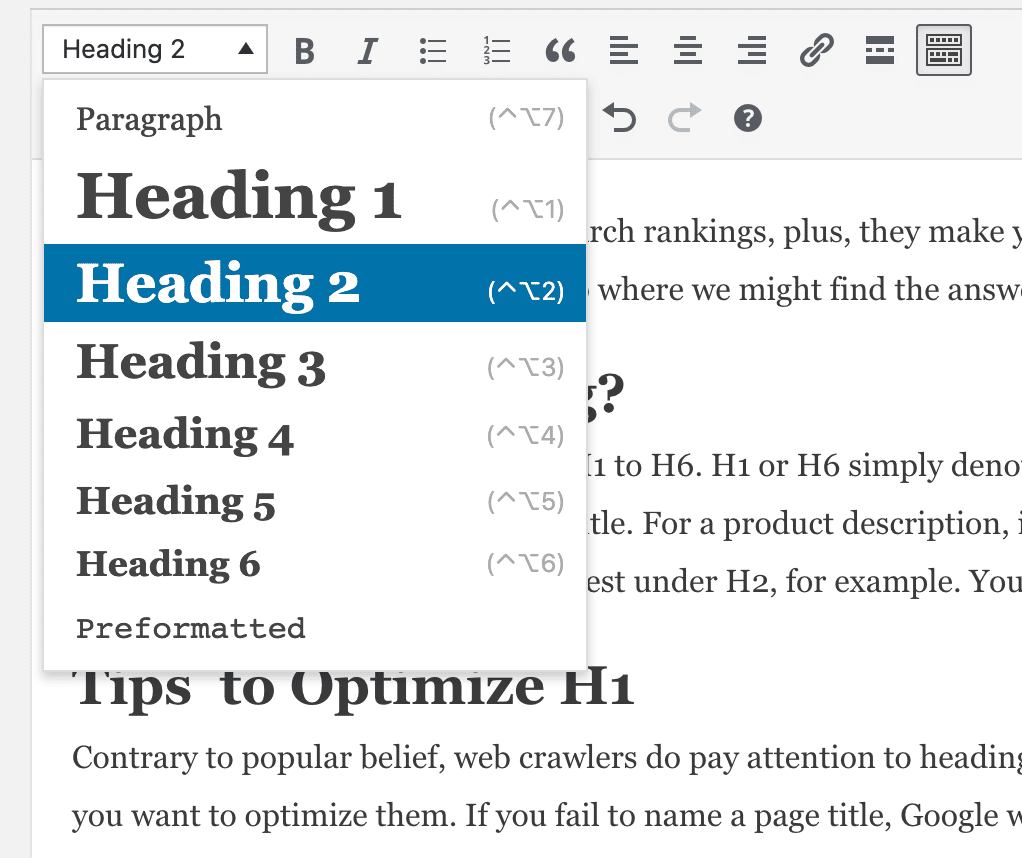Headings can help optimize your search rankings, plus, they make your content easier to read. Let’s face it. Most of us are impatient. We skim ahead to what interests us or to where we might find the answer we want. Headings make content easily digestible and simple to skim.
What Is A Heading?
Headings exist in a hierarchy from H1 to H6. H1 or H6 simply denotes in HTML where it will appear on the page. H1 sums up your main idea. For an article, it would be the title. For a product description, it would be the product name. Each subsequent heading is a subheading in descending order. So, H3 would nest under H2, for example. You should always use H1 and H2, but H3 through H6 are optional.
 Tips to Optimize H1
Tips to Optimize H1
Contrary to popular belief, web crawlers do pay attention to headings. Backlinks may matter more, but headings can affect your rankings so you want to optimize them. Your page title will likely be your main H1 heading of the page. If you fail to name a page title, Google will pull your H1 and display it as the title. So, your H1 (or page title) needs to be exact, engaging, and well-optimized.
- Sum up your main idea in your H1.
- Keep your H1 under 65 characters.
- Only use one H1 heading.
- Optimize H1 with your focus keyword.
- Make your H1 catchy. It should make users want to keep reading.
Tips to Optimize H2
H2s are equivalent to the chapters of a book. So like H1, they should sum up what is under them. If optimized well, H2s can show up on Google as featured snippets. If a user googles a question, Google may pull the answer from one of the sites listed on the first page of results.
If you optimize your H2 with a long tail keyword then directly address that in the text below, your page has a better chance of being pulled for a snippet. For example, the long-tail keyword you use as your H2 might be “how to be a good mom.” Directly after your H2, you would explain how to be a good mom. If you include a bulleted list to answer your user’s question, that’s even better for your SEO.
 Use at least three H2s.
Use at least three H2s.- Keep the text immediately after an H2 below 300 words.
- Optimize H2s with long-tail keywords.
- Be sure each H2 accurately sums up the following paragraph(s).
- Try to keep all of your H2s relatively the same length.
Balance UX and SEO
Most pages don’t use anything beyond H3, so don’t feel pressured to use more than H1 or H2s. And, don’t get carried away and try to stuff your headings with too many keywords or synonyms. You can use plug-ins like Yoast to analyze your use of headings and subheadings. Yoast will let you know if you have too much run-on text without a heading or if your headings need more optimizing. The key to a great SEO page is an equal balance between user-friendly and search engine optimization. Your headings will be signposts to guide readers through your page’s content. Above all, they need to make sense and flow well.
Do you have questions? We’re here to help and ready to assist you in any way. Reach out and let us know what we can do to better serve you!
LET'S ASSESS YOUR WEBSITE AND SEO OPPORTUNITIES
Get your comprehensive and customized complimentary website and SEO (Search Engine Optimization) audit report.



